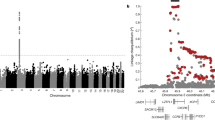Abstract
FOR many years now, we have been working on the epidemiology of Down's syndrome (mongolism) in the State of Victoria, Australia, and have charted its occurrences during 1942–64. Peaks of incidence, of 2-year duration have been recorded at 5–7 year intervals from 1942 until 1957 and, as a result of this, a further peak of occurrence for this congenital anomaly was forecast for 1962–63. This was the first time ever that such a forecast had been able to be made and, in fact, this eventuated1,2. On the basis of our original findings1,2, we had postulated a hypothesis of an infective virus, of long incubation, affecting mostly, but not exclusively, the ovum of the ageing mother, either directly or through some immunity pattern. Our reasons for this were not only the perception by one of us (A. S.) of a possible clinical relationship between the exposure of the mother to infective hepatitis prior to conception, but also the epidemiological findings that cases of mongol births clustered significantly in time and place, that urban peaks of annual incidence were in every case greater than rural peaks (higher contact rates), and rural peaks followed on one year after urban peaks (suggesting a slow spread of infection out of the high-contact urban areas into the rural areas). Our latest investigations have consisted of an attempt to match the annual occurrence of mongolism in the Melbourne area with the annual occurrence of notifiable infectious diseases during 1952–64, 1952 being the year that infective hepatitis first became notifiable in the State of Victoria. Of all infectious diseases, the incidence of infective hepatitis, charted nine months prior to that of mongolism, has alone shown concordance (Fig. 1); another link in the chain of evidence we had forged relating mongolism to the virus of infective hepatitis, or some process associated with the infection, affecting the ovum prior to, or about the time of, conception. The correlation coefficient between the incidences of mongols, per 100,000 live births, and those of infective hepatitis, per million of population, was 0.81, significant at the level of P < 0.01.
This is a preview of subscription content, access via your institution
Access options
Subscribe to this journal
Receive 51 print issues and online access
$199.00 per year
only $3.90 per issue
Buy this article
- Purchase on Springer Link
- Instant access to full article PDF
Prices may be subject to local taxes which are calculated during checkout
Similar content being viewed by others
References
Collmann, R. D., and Stoller, A., Amer. J. Publ. Hlth., 52, 813 (1962).
Stoller, A., Collmann, R. D., Med. J. Austral., 1, 1 (1965).
Collmann, R. D., and Stoller, A., J. Ment. Defic. Res., 76, 22 (1962).
Author information
Authors and Affiliations
Rights and permissions
About this article
Cite this article
STOLLER, A., COLLMANN, R. Virus Aetiology for Down's Syndrome (Mongolism). Nature 208, 903–904 (1965). https://doi.org/10.1038/208903b0
Issue Date:
DOI: https://doi.org/10.1038/208903b0
This article is cited by
-
Parental origin of the extra chromosome in Down's syndrome
Human Genetics (1977)
-
Effects of Low-dose X Irradiation on the Chromosomal Non-disjunction in Aged Mice
Nature New Biology (1973)
-
Seasonal variation in the birth of children with aneuploid chromosome abnormalities
Humangenetik (1973)
-
Down's Syndrome and Maternal Age
Nature (1969)
Comments
By submitting a comment you agree to abide by our Terms and Community Guidelines. If you find something abusive or that does not comply with our terms or guidelines please flag it as inappropriate.



